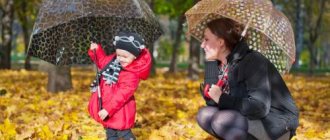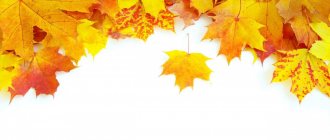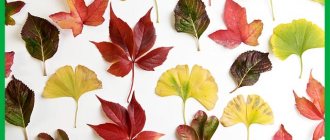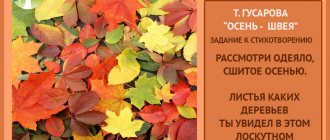Consultation for parents. Theme AUTUMN
Transcript
1 Consultation for parents Topic AUTUMN
2 1. Talk to your child about what time of year it is. You can ask him questions and offer to give complete answers to them. Explain how your questions should be answered. For example: - What time of year is it? (It's autumn now) - Why do you think so? (It has become cold outside, it often rains) -What happens with the onset of autumn? (In autumn, the leaves turn yellow, red, and fall off.) -What happens to animals and birds in the fall? Birds fly away to warmer regions. Animals are preparing for winter. — Why do birds fly to warmer regions? (It became cold outside) How did people’s clothes change and why? (It became cold outside, so people began to dress warmer) 2. Help your child remember that autumn can be divided into early and late autumn. Tell your child how they differ from each other. In early autumn it is still warm, the sun shines often, and it rarely rains. The leaves on the trees begin to turn red and yellow, which is why early autumn is called golden. Asters, dahlias, marigolds and other autumn flowers are still blooming in parks and gardens. Vegetables and fruits are harvested in the fields and gardens. Lingonberries, cranberries, and mushrooms are collected in the forests. Migratory birds gather in flocks and prepare to fly south. In late autumn it becomes cold, the sun shines less and less often and no longer warms at all, and cold drizzling rains often fall. Trees are falling
3 last leaves. The grass dries up, the flowers wither. The flight of birds to the south ends. 3. Look at the pictures “Early Autumn” and “Late Autumn” with your son or daughter. Invite your child to tell the pictures about early and late autumn. If this is difficult for him, ask him questions, have a conversation comparing pictures. What time of year do we see in the first picture, what season do we see in the second? (In the first picture it is early autumn, and in the second it is late.) What day is shown in the first picture, and which day is shown in the second? (In the first picture it is clear and sunny, and in the second it is snowy and cold.) What leaves do we see on the trees in the first picture? What about the trees in the second picture? (In the first picture there are multi-colored leaves on the trees, and in the second the trees are already bare.) What does the water in the pond look like in the first and second pictures? (In the first picture the water seems light and not very cold, but in the second it is dark and cold.) 5. You can read a poem about the autumn months. Autumn Three months, three brothers On shift every year, September, October, November Unlimited period. Only summer waves its hand September on the threshold It is very warm, hot Like summer, but a little Longer than the nights have become, And the days are a little shorter, Although very hot, Like a summer path And on a wave, on a warm wave, We will meet October, A beautiful month, bright Colors the days crimson. The painted trees are as beautiful as always, When the middle brother came, The cities sparkle. But then November came, He is the eldest brother, He invited the rains with him, Brother is glad of the cold!
4 And there is no more scarlet, And there are no bright flowers, We see that November is already ready for winter. He has friendship with winter, He looks like her, Snow, ice, frost, He is very similar to winter. These are the three brothers, Their change every year, September, October, November, There is no limit on the period. 4. Learn with your child a quatrain that will help him remember the names of the months of autumn: September, October, November, With rain and falling leaves. And the birds fly away, and the children need to go to kindergarten. 5. Invite your child to divide the names of the autumn months into parts (syllables). Remind: there are as many syllables in a word as there are vowel sounds (Sep - September, Ok - October, but - November). 6. On a walk, you can train your child in the ability to recognize maple, oak, birch, rowan, poplar, aspen, and ash. Pay attention to the characteristic features of the trunk, branches, bark, leaves. Talk with your child about the color of autumn leaves, using the adjectives gold, scarlet, crimson, crimson. For example. Scarlet maple leaves, golden birch leaves, crimson aspen leaves, crimson rowan leaves. 7. You can play the game “Autumn Leaves” with your child. You throw a ball to the child and name the tree, the child returns the ball to you, forming a phrase with two adjectives. For example. Birch yellow birch leaves, maple scarlet maple leaves, aspen crimson aspen leaves, rowan orange rowan leaves. 8. Play the game “Give me a word” with your child: The birds are flying away, the flocks have gathered. The leaves fly away, the wind carries them away. All this happens if it’s with us (autumn).
5 9. Learn the following text with your child and do finger exercises. It promotes the development of fine (finger) motor skills, will help you easily remember relative adjectives (oak, maple, rowan), and will be useful during a moment of rest when writing or drawing. Check whether the child himself can form relative adjectives from the nouns birch, aspen (birch, aspen). The wind flew through the forest, Smooth wave-like movements with the palms The wind counted the leaves: Here is a large oak tree. We bend the fingers on both hands. Here's a golden one from a birch tree. Here is a carved maple leaf. We open our palms. Here is the last leaf from the aspen tree The wind threw it onto the path. We lower our hands down.
MAGAZINE Preschooler.RF
Consultation for parents “How to explain to a child what autumn is for young children?”Completed by the teacher of GBDOU No. 82 of the Moskovsky district of St. Petersburg Oksana Mikhailovna Arkhipova
Goals:
- Teach children to name the signs of autumn, changes in the weather, and use figurative words and expressions for autumn;
- learn to compare essential features of phenomena;
- Expand children's horizons about natural changes in autumn, about the life of birds and wild animals;
- Carry out fun walks for kids with their parents;
- Get a clear idea of seasonal phenomena through walks with your parents;
- To cultivate attention, love of nature, caring attitude towards animals, birds, positive character traits.
- Convey color combinations characteristic of late autumn in the drawing.
What is autumn?
How to make an autumn walk interesting and interesting for children
cognitive? What can you do with your child on a walk in the fall?
Autumn is a transitional season, at this time nature changes very quickly. First, bright colors appear, then the leaves fall from the trees, and they become gray and dull. The air temperature drops, and the child understands that it is getting colder outside every day. Clothes become bulky, heavy and not very comfortable. But it is precisely at this time of year that it is easy to attract children's attention to nature, interest them and show them how life works. “Herbarium” One of the most interesting activities at this time of year is assembling a herbarium and making crafts from natural materials.
Every season feels like the first time for kids. Therefore, it is important to give them the opportunity to learn the concept of seasons through experience. This will form the basis of a coherent picture of the world. Fortunately, solving such a problem is not at all difficult.
Surveillance in the yard
Let's look around and think - what has changed in the usual picture with the arrival of autumn? Let one - a single tree - grow in the yard and it can become a wonderful resource. Come up to it every few days - look at and touch the leaves. Swinging on a swing, you can “fly with the birds” to warmer climes. And admire the color of the autumn sky. In the sandbox - touch the cool sand and pay attention to the warm clothes of your friends. And then go with them in search of thin crusts of ice. If you hold this transparent, fragile miracle in your hand, the baby will see and feel it. How a cold piece of ice turns into a warm drop before your eyes. That's the trick.
Walk to the park
Here you can admire the colors of autumn. Inhale its unique aroma! Go for a walk in the park or forest more often - both on fine leaf days and on cloudy days. "Magical nature" .
This activity consists of simply walking, observing, listening to the sounds around you: the rustling of leaves under your feet, the chirping of birds. While walking, remember the signs of autumn, and maybe you will see a flying cobweb or a lot of rowan berries on the trees.
Signs of autumn
- Squirrels make a large supply for the winter - expect severe frosts in winter.
- There are a lot of rowan trees, which means that the autumn will be rainy and the winter will be frosty.
- Migratory birds fly high - the cold is already approaching.
- If the leaves fall from the trees very quickly, then the winter will be cold.
- The leaves from the birch trees fall unevenly—there won’t be any snow for a long time.
- A cat hides its face and covers it with its tail - it means it will get colder.
Where else can you find so many interesting objects to explore?! Moreover, you can touch, feel, smell all this. Give your baby complete freedom.
Are you worried about the condition of your clothes after a walk? Bring spare clothes with you. And let your child have fun for his own pleasure, for example, collecting armfuls of fallen leaves...
In different parts of the park you can observe the diversity of landscapes and plants. Today you will admire the spreading maple and collect an elegant bouquet under it. Tomorrow add rowan branches to the composition. Oak will rightfully take pride of place in walks. One day he discovered a smooth acorn under it, and even with a cute cap.
Conversation
How can you make a walk even more beneficial for your child’s development?
Pay attention to individual elements of the world around you. Take a leaf in your hand, place a ladybug on your palm, and run your baby’s hand along the bark of the tree.
Speak out everything you are considering, mark the signs and properties with words. “Here is a maple leaf. Wide carved, similar to your palm. This one is yellow. And here is the red one .
Develop musical abilities, aesthetic taste, the ability to show emotional responsiveness to music, develop creativity and creativity.
Encourage them to express their impressions of listening to classical works in creative activities, performing arts, and speech activities.
Photograph your child against a luxurious backdrop, and don't forget to photograph everything around him. Such photographs will help to revive your memory of a recent walk and consolidate your impressions.
Procurement of natural material
You can collect natural materials all year round, as each season has its own charms. Autumn provides a particularly rich palette of colors with the golden and crimson leaves of autumn trees.
Harvested natural material can be used in creative works. The more diverse the collected material, the easier it will be to work with it. But the leaves can be used in applique, giving it different shades or as a background. Spruce and pine cones can be used in working with plasticine, making a variety of forest animals. The collected dry roots, branches, cones, and twigs have a bizarre shape. You can invite children to answer the following questions:
“What does it look like? What does it remind you of? This encourages the children to compare them, remember familiar fairy-tale characters, carefully look at the material, think through their imagination in advance, what can be made from it, what composition can be created (with the participation of people, animals, birds, fish, etc.).
| Next > |
Childhood is a unique and magical time, and there are no cloudy days, no piercing winds, no cold rain. For a child, there are no obstacles in the form of autumn slush - he is drawn to the street, where he loves to play at any time of the year and in any weather. Let’s enjoy life with our children, because it’s no coincidence that they say that nature has no bad weather!” And to help children notice the changes occurring in nature in the fall, parents need to admire this wonderful time of year with their child.
Parents are recommended:
- Invite your child to guess the riddle: “The fields are empty, the ground is getting wet, the day is waning, when does this happen? ";
- Tell your child about autumn, about the changes taking place in nature;
- Look at pictures depicting early and late autumn, paying special attention to the appearance and condition of the trees: in early autumn they are covered with colorful foliage, and in late autumn they are bare;
- Together with your child, compare people’s clothes in early and late autumn;
- Draw his attention to how the weather has changed: have the days become longer or shorter, has it become warmer or colder outside? Tell where and why the birds flew away;
- Learn the poem with your child:
"Gifts of Autumn"
Autumn is walking in our park, autumn gives gifts to everyone:
Red beads for rowan, pink apron for aspen,
A yellow umbrella is for poplars; autumn gives us fruits.
- Learn the riddle.
In spring and summer we saw him dressed,
and in the fall all the poor girl’s shirts were torn off. (tree)
- Offer to play the didactic game “What trees do you know? Name them? "
- Secure parts of trees (trunk, roots, branches, leaves) with the child.
- Teach your child to form adjectives: birch leaf - birch, oak leaf - oak, maple leaf - maple, aspen leaf - aspen.
- Learn to form the plural from words: tree, trunk, birch, oak, rowan, poplar, aspen, maple.
- Offer to draw a tree in early autumn and late autumn. (What is the difference)
- Suggest - “Tell me what you will wear for a walk in the fall, what you will take with you in order not to get wet.”
Dear parents! If you listen to these recommendations, your child will be very grateful to you, as his stock of knowledge will be enriched, previously acquired knowledge will be consolidated, and the ability to notice the beauty around him will develop! And most importantly, he will be pleased and interested in communicating with you!
We wish you success in raising your children!
The material was posted by Shchetkova I.A.
Consultation for parents of 2-3 year old pupils “Autumn walks with kids”
Consultation for parents of 2-3 year old pupils on the topic:
"Autumn walks with kids"
Starting a conversation about walks with kids, I’ll give an example: “A grandmother came to the playground with her grandson. The child flew up the hill, with an enthusiastic cry, dashed down, jumped up and rushed up again. This would have gone on for a long time if a flying dove had not caught the baby’s eyes. The baby rushed after him across the flowerbed, through the children's buildings in the sandbox, but the dove flew away. Grandma sighed: “The only salvation is this playground. The granddaughters come running, have dinner with an appetite and sleep until 11 o’clock, and at this time we all relax.” Adults make an unforgivable mistake, believing that both they and the kids can relax during a walk. After all, the process of education is continuous.
The first thing a child encounters on a walk is nature, which he needs to be introduced to: help him understand, love, teach the child to treat it with care...
Watching living objects or the work of adults, children, by virtue of their own activity, strive to help them: feed a kitten, water a flowerbed, etc. Children are busy with interesting and useful things, learn to finish what they start, communicate with people, be they adults or peers , acquire practical dexterity. Children should be taught to observe animals and natural phenomena; they can be random and unexpected, and an adult should not miss this opportunity. Remember that every day in nature is unique!!!
Don’t rush to immediately explain something to your child every time, give him the opportunity to figure it out on his own. Teach to explore and think actively. Ask him questions often.
So, what can you do with your child in the fall?
Observation of wildlife.
Plant Observations
Flowers.
In a meadow, field or near a flower bed, show the children 2-3 flowers, tell them what they are called, ask what color the leaves and flowers are? Bring to your own conclusion: all flowers have green leaves. In subsequent observations, give tasks: “Find blue flowers in the clearing, and now yellow, white, name the white flower (daisy). Find pansies in the flowerbed? etc.
Children look with interest and name the parts of the plant: flower - stem - leaves.
Grasping the head of an aster or dahlia, the child sees: the flower does not fit in the palm - large, fluffy. The kid runs his finger along the stem - it’s long. You can smell mignonette and phlox. What a scent!!!
Vegetables, fruits, berries.
Amazing discoveries await a child in the garden. It turns out that some vegetables are openly displayed in the beds, while others need to be found in the foliage. “They’re playing around and hiding,” the kid decides. But there are also those who sit on the ground, and it’s not easy to get them out of there! The child pulls out a carrot. The meaning of the riddle becomes clear to him: “The red maiden is sitting in the dungeon, and the braid is on the street.” Children master the concepts: “shape” (oblong carrot, round onion, oval zucchini), “color,” “size,” “character of the surface” ( smooth turnips, rough, “prickly” cucumbers, hard potatoes, soft tomatoes). They taste the vegetables, ask which ones can be eaten raw, which ones can be cooked. They remember which animal likes to chew carrots and cabbage. By the age of 3, children can list up to three names of vegetables; When comparing two tomatoes, they note: smaller - larger, lighter - heavier, cucumbers - shorter - longer, thinner - thicker.
Personal website of teacher Natalya Anatolyevna Sokolova
Consultation for parents
“Features of children’s nutrition in autumn”
Nutrition for preschoolers in the fall should be organized in such a way that the child’s body can develop normally. Over the summer, everyone got used to the abundance of fruits on the table, and to make it easier to adapt to the autumn period, we need more nutritious food. Without it, it will be very difficult for children to fight viral attacks and resist low temperatures.
The child's body is not fully formed, so it needs more calories. In this regard, it is recommended to supplement the baby’s diet with grains. They contain a lot of carbohydrates and break down slowly, which means they supply the child with additional energy.
There are foods that should be excluded from a child's diet: fatty meats, canned food, sausages and spicy seasonings. Many culinary recipes recommend using dill, parsley, onions and garlic to improve taste. These plants can not only improve the taste of food, but also inhibit the growth of pathogenic microbes.
To maintain body temperature in the autumn, fats are needed. Children should be given cheese, butter, cottage cheese and milk. These products contain a lot of calcium, which means they guarantee healthy bones for the child. In addition, a preschooler needs to regularly consume meat, poultry and fish, since without them normal development of the body is impossible. Nutrition for preschoolers in the fall should be organized in such a way that the child’s body can develop normally. Over the summer, everyone got used to the abundance of fruits on the table, and to make it easier to adapt to the autumn period, we need more nutritious food. Without it, it will be very difficult for children to fight viral attacks and resist low temperatures.
How to fortify your child's food in the fall!
To improve the functioning of a child’s immune system in winter, it is necessary to fortify his diet throughout the summer and autumn. Autumn is very rich in ripe fruits and vegetables, which are the main storehouse of vitamins and beneficial microelements. Therefore, in the autumn, be sure to introduce vegetables into your children’s diet, such as cabbage, carrots, bell peppers and many others. Having received a sufficient amount of vitamins, the child’s body will better resist various viral and infectious diseases.
Sources of Vitamin C
To replenish a child’s body with vitamin C, it is necessary to introduce into his diet vegetables such as bell peppers, which are the leader among vegetables in the content of this vitamin; cabbage, and it doesn’t matter at all whether it’s fresh or pickled; apples, especially those with sourness, are also very rich in vitamin C. In order for a child to receive the necessary daily intake of vitamin C, it is necessary that he eats only one fresh sweet pepper or 200 grams of cabbage salad. It is best to give your child vegetables raw, as vitamin C is destroyed by high temperatures.
Sources of vitamins A and B6
Carrots are a real storehouse of these vitamins. Vitamin A helps strengthen the immune system and increase the body's resistance to infections. Vitamin B6 is also an excellent immune system protector and plays a critical role in the formation of lymphocytes (blood cells). In addition to carrots, these vitamins contain vegetables such as potatoes, cabbage, beans, beans, peas, green onions, and spinach. However, it is necessary to take into account that vitamin A is better absorbed with the help of fats, so salads made from these vegetables are best seasoned with vegetable oil.
Sources of vitamin B1 (thiamine)
To strengthen the child’s nervous system, as well as improve the functioning of his digestive system, the diet should contain vegetables such as peas, beans, tomatoes, and spinach. The daily need for this vitamin is not that great, only 2-3 mg, but its absence can contribute to the development of various diseases.
How to cook vegetables to preserve vitamins
To preserve the nutritional value of vegetables, they must be properly processed and cooked. Vegetables should be washed in cold running water. Remember that the bulk of the vitamins and minerals in vegetables are under the skin, so the thinner you peel them and cut them larger, the less vitamin loss there will be.
If you need to boil vegetables, it is best to do this unpeeled, so that the vitamins contained in them are less destroyed. It’s even better if you stew them, bake them on the grill or in the oven, or steam them. It is best to put greens in ready-made dishes, and if you still need to boil them, then for no more than 5 minutes.
Know that autumn is the most fertile time for fortifying a child, since fresh vegetables have the highest content of vitamins, and during long-term storage, even in the best conditions, some vitamins and minerals are destroyed. However, vegetables and fruits must be given to the child all year round in order to replenish the body's reserves of useful substances.
Dried fruits are a valuable source of vitamins and fiber. They not only stimulate brain and motor activity, but also improve immunity. Walnuts strengthen the central nervous system and nourish brain cells. Peanuts are very useful for children's bodies, as they restore metabolism and help fight colds.




